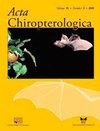一种快速、原位微创技术评估蝙蝠假体育馆孢子虫感染情况
IF 0.7
4区 生物学
Q4 ZOOLOGY
引用次数: 5
摘要
新出现的传染病可能会对野生动物构成严重威胁,白鼻病就是一个突出的例子。在WND的情况下,喜冷真菌Pseudogymnoascus destructans在蝙蝠冬眠期间定居,侵入皮肤,已经导致北美数百万蝙蝠死亡。毁灭性假单胞菌很可能起源于欧洲,在那里它也会引起病变,但没有相关的死亡。然而,目前尚不清楚欧洲蝙蝠是如何应对这种真菌的。因此,拥有准确表征疾病进展的工具是很重要的。由于冬眠是蝙蝠容易受到干扰的一种生理状态,因此应以最小的侵入性对临床状态进行原位评估,以避免对蝙蝠造成不利影响。然而,目前可用的疾病评估方法需要处理/触摸蝙蝠,因此具有侵入性:i)紫外线穿透翼膜照射以检测病变,以及ii)基于qPCR的翼膜拭子真菌物质定量。由于破坏性疟原虫(P.destructans,“Pd”)在所有没有毛皮的皮肤上都可以看到,具有不同的分布模式,我们研究了在不接触蝙蝠的情况下使用可见症状来评估感染水平。我们介绍了一种我们称之为“视觉Pd评分”(一种视觉分类方案)的技术,该技术可以在不干扰动物的情况下应用。为了评估其可靠性,我们使用了感染大鼠耳蝙蝠的P.destructans(心肌炎),将新方法与现有的两种金标准技术进行了比较。我们的研究结果表明,从所有三种技术中获得的感染水平是相关的。重要的是,视觉Pd评分所携带的信息最类似于组合了基于qPCR和紫外线定量方法的信息的复合指数。我们得出的结论是,视觉Pd评分是一个很有前途的指标,可以更好地描述疾病的严重程度,因为它同时代表真菌定植和翅膀损伤。我们讨论了应用技术的优点和缺点,并得出结论,视觉Pd评分对常规冬眠计数或大规模破坏性疟原虫监测特别有用。与病变检测技术相结合,新方法也适用于免疫学研究,在免疫学研究中,必须调查真菌定植和相关损伤,而如果有必要检测隐性感染,例如在早期冬眠期间,来自所有身体部位拭子的qPCR尤其有用。本文章由计算机程序翻译,如有差异,请以英文原文为准。
A Rapid, in-Situ Minimally-Invasive Technique to Assess Infections with Pseudogymnoascus destructans in Bats
Emerging infectious diseases may become serious threats to wildlife, a prominent example being the white-nose disease (WND). In case of WND, the cold-loving fungus Pseudogymnoascus destructans colonizes bats during hibernation, invades the skin and has already lead to the death of millions of bats in North America. P. destructans most likely originated from Europe, where it also causes lesions but without associated mortalities. However, it is still unclear how European bats cope with the fungus. Hence, it is important to have tools that precisely characterise disease progression. Because hibernation is a physiological state during which bats are vulnerable to disturbance, in-situ assessments of the clinical status should be carried out minimal-invasively to avoid detrimental impacts on bats. However, currently available disease assessment methods require handling/touching bats and are therefore invasive: i) UV-light trans-illumination of wing membranes to detect lesions and ii) a qPCR-based quantification of fungal material from wing membrane swabs. Since P. destructans (‘Pd') becomes visible on all furless skin with distinct distribution patterns, we investigated the use of visible symptoms to assess levels of infections without handling/touching bats. We introduce a technique which we termed ‘Visual Pd-score’ (a visual classification scheme), which can be applied without disturbing the animals. To assess its reliability, we used P. destructans infected greater mouse-eared bats (Myotis myotis) to compare the novel method with the two existing golden-standard techniques. Our results show that infection levels obtained from all three techniques are correlated. Importantly, the information carried by the Visual Pd-score is most similar to a composite index combining the information from the qPCR-based and UV-light quantification methods. We conclude that the Visual Pd-score represents a promising index to better characterise disease severity as it is simultaneously representative for fungal colonization and wing damage. We discuss advantages and disadvantages of the applied techniques and conclude that the Visual Pd-score is particularly useful for routine hibernacula counts or large-scale P. destructans-surveillance. In combination with the lesion detection technique the new method is also applicable to immunological studies where both fungal colonization and associated damage have to be investigated, while qPCRs from swabs of all body parts are especially useful if it is necessary to detect cryptic infections, e.g. during the early hibernation period.
求助全文
通过发布文献求助,成功后即可免费获取论文全文。
去求助
来源期刊

Acta Chiropterologica
生物-动物学
CiteScore
2.50
自引率
20.00%
发文量
42
审稿时长
>12 weeks
期刊介绍:
Acta Chiropterologica, published by the Museum and Institute of Zoology at the Polish Academy of Sciences, is devoted solely to the study and discussion of bats.
 求助内容:
求助内容: 应助结果提醒方式:
应助结果提醒方式:


